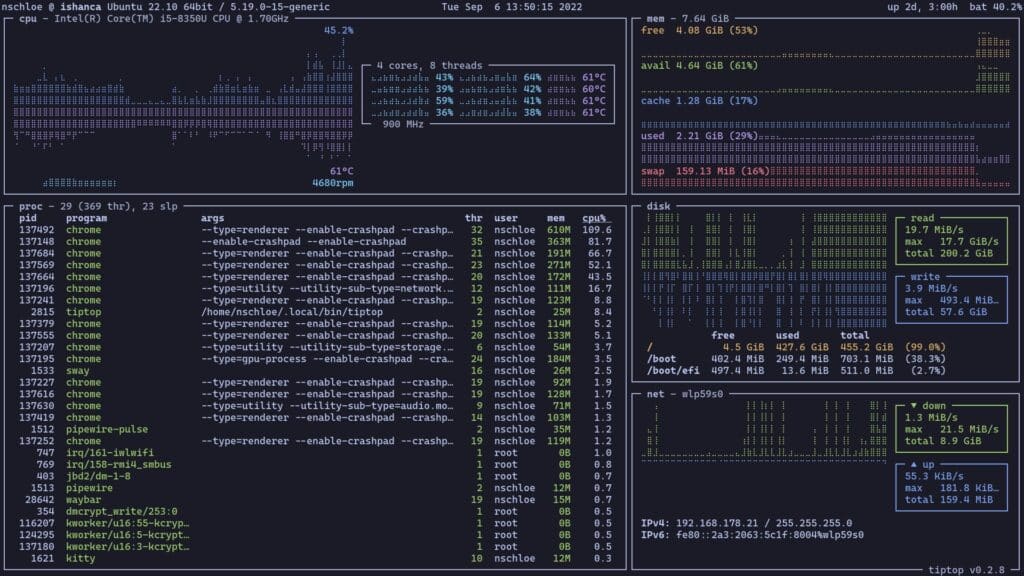In the realm of system administration and performance monitoring, having efficient and flexible tools is essential to ensure the optimal operation of technological environments. In this context, Tiptop stands out as a powerful and lightweight solution designed to provide detailed real-time system statistics directly from the command line.
What is Tiptop?
Tiptop is a performance monitoring tool that offers a dynamic view of active processes in a system. Inspired by the popular top utility, Tiptop excels by deriving most of its information from hardware counters, enabling a detailed analysis of system performance. Its versatile design makes it compatible with operating systems such as Linux, Windows, and macOS, making it particularly useful for system administrators, developers, and analysts.
Key Features
- Real-Time Monitoring: Tiptop allows users to observe resource usage such as CPU, memory, and network activity in real time. It presents detailed statistics in a graphical format within the terminal, making them easy to interpret.
- Multi-Platform Compatibility: Although optimized for Linux (requiring at least version 2.6.31), Tiptop also functions seamlessly on other platforms, showcasing its flexibility and portability.
- Operating Modes:
- Interactive Mode: Displays real-time data and enables users to interact with the tool to adjust configurations, filter processes, or modify refresh intervals.
- Batch Mode: Ideal for collecting data and saving it to files for later analysis. This mode does not allow interaction during execution.
- Advanced Configuration Support: Tiptop can be customized through an XML configuration file. This file allows users to define custom screens, specific columns, and metrics calculated from available hardware counters.
- Filtering Options: Users can filter processes by user ID (UID), process name, or specific tasks, ensuring the focus is on the most relevant elements.
Use Cases in Enterprise Environments
In enterprise environments that rely on advanced infrastructures, such as those managed by Stackscale (Grupo Aire), Tiptop becomes an essential tool to ensure system performance and stability. Practical use cases include:
- Resource Optimization: Tiptop’s ability to display detailed metrics helps identify bottlenecks in real time and adjust configurations to maximize performance.
- Hardware Usage Audits: By leveraging hardware counters, Tiptop provides granular insights into system usage, helping administrators identify inefficient or resource-intensive processes.
- Remote Monitoring: Combined with remote access tools like SSH, Tiptop allows monitoring of servers and distributed systems from any location.
Installation and Configuration
Installing Tiptop is straightforward and available via package managers such as pip. Configuration can be done directly from the command line or via an XML configuration file. Common commands include:
- Basic Installation:
pip install tiptop - Run in Interactive Mode:
tiptop - Set a Custom Refresh Interval (in seconds):
tiptop -d 5 - Batch Mode for Exporting Data:
tiptop -b -o output.txt
Interactive Interface
In interactive mode, Tiptop offers quick commands to navigate through data, sort columns, and customize the display. Some useful commands include:
- Filter Processes by User:
u - Change Refresh Interval:
d - Show Idle Processes:
i - Kill a Process:
k - Sort by Column:
<or>
Advantages Over Traditional Tools
While tools like top and htop are widely used, Tiptop stands out for its focus on hardware metrics, enabling a more detailed analysis of processes and their impact on system performance. Its flexibility and ability to run in batch mode make it an ideal choice for automating monitoring tasks.
Conclusion
Tiptop is an indispensable tool for professionals seeking to monitor and analyze system performance with precision and efficiency. Its lightweight design, combined with advanced features and customization options, makes it an ideal solution for both personal and enterprise environments.
In critical infrastructures like those managed by Stackscale, tools like Tiptop play an essential role in maintaining and optimizing systems. For more information, visit the official Tiptop repository.

